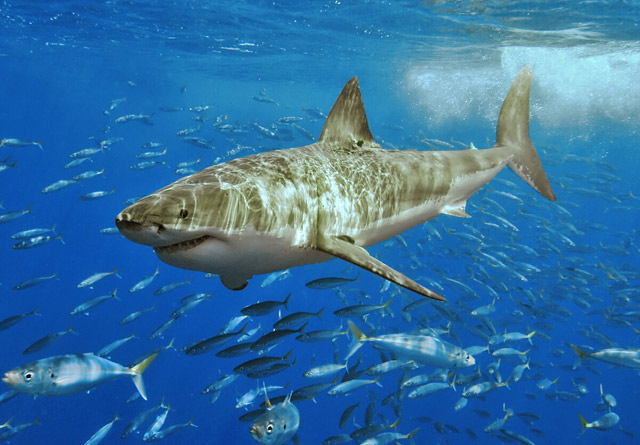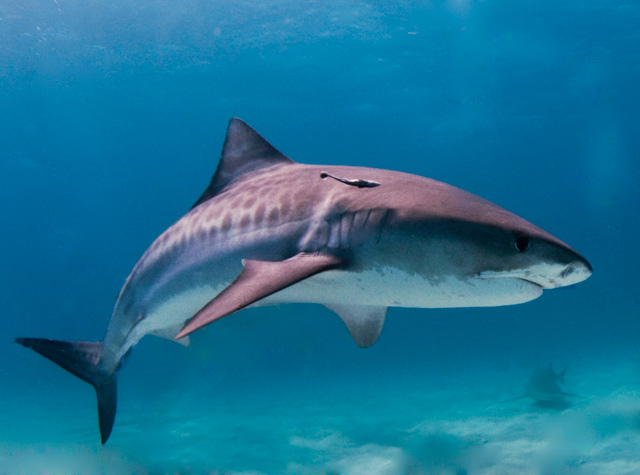Santa Barbara’s Summer of the Shark
Are There More Sharks in the Channel?

The Discovery Channel’s 25th annual installment of Shark Week — the around-the-clock, shark-porn-powered programming on cable TV’s most popular science-themed channel — may have concluded last Friday, but shark fever continued in earnest this week on the South Coast.
For the third time in as many weeks, officials were busy Sunday afternoon putting up warning signs at beaches from Carpinteria to Goleta after yet another reported sighting of a shark swimming in near-shore waters. Adding to the hysteria is the fact that many of the sightings and injured seals and sea lions that have been washing ashore this summer have been attributed to one of the Pacific Ocean’s most celebrated apex predators, the great white shark.
Of course, great white sharks are just one of roughly 12 shark species that regularly swim in the Santa Barbara Channel, a group that also includes the shortfin mako (often mistaken for a great white by the untrained), the blue shark, and the tiger shark.
Further, as Dr. Chris Lowe told The Santa Barbara Independent during an interview a few years ago, the waters of the Channel, with its nutrient-rich upwellings, robust fin-footed mammal and fish populations, and strategic location just below the Bight of California, is the “nursery of the Eastern Pacific.” As such, explained the California State University, Long Beach professor and head of its esteemed Sharklab, the area is often the summer-season home for juvenile sharks such as the young great whites that have provided the bulk of this summer’s sightings. “This is their habitat,” stated Lowe. “They belong here.”
So why then does it seem, at least from your typical landlubber’s perspective, that this summer has been “sharkier” than normal? For his part, Lowe, who is currently in Alaska but answered some questions via email, isn’t convinced that this summer is any different from the past decade or so when we have also had a fair amount of near-shore, shark-related incidents (be they sightings or otherwise) during the summer and fall months.
“I don’t think this year is that unusual, but I do think the population is increasing,” explained Lowe. He added that, due to the potential population increase (a theory based in part on a recent study that looked at historic interactions between great whites and various fisheries), such shark events will only increase in the future.
Another possible reason for the seeming uptick is the fact that, after 2010’s tragic death of UCSB student Luke Ransom at the jaws of a great white while he boogie-boarded near Surf Beach in northern Santa Barbara County, both the county and the City of Santa Barbara have adopted official protocols for informing the public after a credible shark sighting is reported. Prior to this, it was not common practice for officials to send out press releases or post warning signs at area beaches for 72 hours following a shark sighting.
However, ask any regular user of the Santa Barbara Channel, and most will be quick to tell you that sharks are anything but an unexpected part of their experience, especially when working or recreating in certain areas of the ocean like offshore reefs or near seal haul-outs and rookeries. Add to this the fact that, in this great digital age, we are more connected than ever, and you get the idea that perhaps it isn’t so much that these incidents are more frequent but rather that we are simply hearing about them more.
Speculation aside, there is no doubt that, for the average follower of news in Santa Barbara, this summer has seen more shark headlines than ever before. The following is a list of confirmed shark sightings and related beach warnings compiled with help from the Shark Research Committee, the Santa Barbara Marine Mammal Center, the City of Santa Barbara, and the County of Santa Barbara.
It should also be noted that, as of press time, no beaches have actually been closed as a result of these incidents and, more importantly, nobody has been hurt.

• April 18, S.B. Waterfront: An adult female sea lion is found injured near Stearns Wharf. A large bite out of her stomach is later attributed by experts to be the result of a chomp from a great white shark. Based on bite marks, the shark is estimated to be a juvenile approximately eight to nine feet in length.
• July 8, Channel Islands: An estimated 15- to 17-foot great white shark is reported by a fisherman three miles north of Santa Cruz Island.
• July 24, Santa Barbara Beaches: Shark warning signs are posted at all city beaches after an obviously injured adult sea lion is seen by officials on East Beach and a buoy just outside S.B. Harbor. After studying bite marks, experts believe the sea lion was bitten by a great white. Later recovered by the Marine Mammal Center, the sea lion is eventually euthanized.
• July 25, Leadbetter Point: Charter boat captain Dan Collie witnesses a shark feeding on a sea lion just up the coast from Leadbetter Beach.
• Early August, Gaviota State Park: Officials and regulars at Gaviota State Park’s pier report numerous sightings of a “large shark,” believed to be a great white, swimming close to the pier pilings.
• August 13, Carpinteria: Volunteers for the S.B. Marine Mammal Center pick up an injured young male Pacific Harbor seal on the beach just east of the seal rookery in Carpinteria. After studying the bite marks, it is believed that the seal was bitten twice by a juvenile great white shark.
• August 14, Carpinteria: A paddleboarder reports seeing an approximately eight-foot shark swimming outside the marker buoys offshore of Carpinteria Beach.
• August 14, Santa Barbara: Warning signs are once again posted at area beaches after a group of surfers get chased from the waves at Leadbetter Beach by a shark. Eyewitnesses say the shark had a spread between its dorsal and tail fin of six or seven feet, indicating that the shark was roughly 10 to 14 feet in total length.
• August 15: Harbor officials confirm that a local urchin diver saw an estimated six-foot great white shark in the waters near the Mesa lighthouse, just west of Leadbetter. The diver was in 20 feet of water when she had the run-in.
• August 19, Goleta: Warning signs are again posted at area beaches, just a day after coming down, after a fisherman saw a 10-foot shark while working the waters well offshore of Goleta Beach early Sunday morning.



